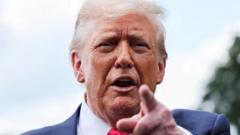Recent trends indicate a boom in demand for gold; however, experts warn of significant risks ahead that could affect investors.
Gold Market Surge: Is It a Safe Investment for the Future?

Gold Market Surge: Is It a Safe Investment for the Future?
As gold prices hit record highs, investors are left questioning the long-term stability of this precious metal.
Gold has become a hot commodity, with prices skyrocketing more than 40% over the last year, hitting an all-time high above $3,500 (£2,630) per troy ounce. Emma Siebenborn, strategies director at Hatton Garden Metals, recounted witnessing extraordinary demand, often seeing sellers queueing in the streets of London's jewelry district. This heightened interest is illustrated by the prospect of significant gold purchases, from shabby jewelry to luxurious coins and bars weighed down by their intrinsic value.
As Zoe Lyons, managing director of the same dealership, pointed out, emotions around the market fluctuate between excitement and anxiety, as investors ponder the future direction of gold prices amidst geopolitical tensions and unpredictable US trade policies. Such emotions, combined with central banks' increased demand for gold, have led many to view it as a safe haven asset despite its past volatility.
Fueling gold’s current appeal are fears of inflation and recession, leading investors to consider this metal a protective measure against market instability. Although gold is not immune to price swings, like cyclical rallies and corrections seen historically, it remains a more stable option than stocks or bonds. However, experts caution that past surges have often precedeed notable drops, raising concerns for investors pondering whether this boom will sustain or give way to a correction.
Current uncertainties surrounding the global economy and geopolitical landscape have driven central banks to increase gold reserves significantly, with record purchases escalating since 2022. Countries like Poland, Turkey, and India are among those that have accelerated their gold buying, partly due to fears of the dollar's fluctuation and potential sanctions.
Gold's rise during times of instability, reminiscent of previous peaks following economic crises, indicates the allure of this asset class. Yet, the fragility of such bullish market conditions can't be ignored. Analysts differ in their forecasts; some anticipate continued price growth owing to strong central bank demand, while others warn of a potential market bubble as supply increases and speculative trading might lead to sell-offs.
The question of sustainability looms large: Will the current momentum hold, or will we witness a market retreat akin to historical trends? The volatility of gold as an investment cannot be overstated; while it currently seems a sound choice for many, investors should consider diversifying their portfolios to mitigate risks associated with short-term speculation. As the future remains uncertain, only time will tell if this glittering asset will shine or dim for those willing to take the plunge.
As Zoe Lyons, managing director of the same dealership, pointed out, emotions around the market fluctuate between excitement and anxiety, as investors ponder the future direction of gold prices amidst geopolitical tensions and unpredictable US trade policies. Such emotions, combined with central banks' increased demand for gold, have led many to view it as a safe haven asset despite its past volatility.
Fueling gold’s current appeal are fears of inflation and recession, leading investors to consider this metal a protective measure against market instability. Although gold is not immune to price swings, like cyclical rallies and corrections seen historically, it remains a more stable option than stocks or bonds. However, experts caution that past surges have often precedeed notable drops, raising concerns for investors pondering whether this boom will sustain or give way to a correction.
Current uncertainties surrounding the global economy and geopolitical landscape have driven central banks to increase gold reserves significantly, with record purchases escalating since 2022. Countries like Poland, Turkey, and India are among those that have accelerated their gold buying, partly due to fears of the dollar's fluctuation and potential sanctions.
Gold's rise during times of instability, reminiscent of previous peaks following economic crises, indicates the allure of this asset class. Yet, the fragility of such bullish market conditions can't be ignored. Analysts differ in their forecasts; some anticipate continued price growth owing to strong central bank demand, while others warn of a potential market bubble as supply increases and speculative trading might lead to sell-offs.
The question of sustainability looms large: Will the current momentum hold, or will we witness a market retreat akin to historical trends? The volatility of gold as an investment cannot be overstated; while it currently seems a sound choice for many, investors should consider diversifying their portfolios to mitigate risks associated with short-term speculation. As the future remains uncertain, only time will tell if this glittering asset will shine or dim for those willing to take the plunge.






















